Best Workforce Analytics Software
Best workforce analytics software platforms include IBM Planning Analytics, Novagems, Acendre Recruitment, SAP SuccessFactors, TalentSoft, and Peopleinsight Workforce Analytics. These software platforms are popular due to their feature-rich interface, robust structure, and excellent integration with third-party apps.



No Cost Personal Advisor
List of 20 Best Workforce Analytics Software
Emergents | 2024
A complete HR solution that improves end to end em
Oracle Fusion Cloud HCM is a reliable workforce analytics software. Oracle Cloud HCM offers a full-stack suite of native cloud-based services for hiring and managing talent workforces. Oracle Cloud HCM offers a full-stack suite of native cloud-based services. The whole range of functions necessary for a top-tier Human Capital Management (HCM) solution is accessible to users. Learn more about Oracle Fusion Cloud HCM
Explore various Oracle Fusion Cloud HCM features, compare the pricing plans, and unlock the potential of seamless operations by selecting the right software for your business.
- Employee Guides
- Reporting/Analytics
- Employee Directory
- Performance Appraisal
- Performance Metrics
- Payroll Management
- Workforce Management
- Talent Management
Oracle Fusion Cloud HCM Caters to
- StartUps
- SMBs
- Agencies
- Enterprises
Emergents | 2024
Workforce Analytics for the Modern ?Workplace
ActivTrack offers trustworthy workforce analytics tools. Businesses can use this software to keep an eye on staff productivity, workload, efficiency, and technology. They can benefit by using ActivTrak's workforce analytics. They can quickly compare metrics across teams and employees using the platform. This cloud-based platform for tracking user productivity gathers data, analyses, and offers insights. Learn more about ActivTrak
Explore various ActivTrak features, compare the pricing plans, and unlock the potential of seamless operations by selecting the right software for your business.
Features
View all ActivTrak Features- Dashboard
- Reports
- Alerts & Notifications
- Real Time Monitoring
- Time Tracking
- File Sharing
- View Chat-Room Conversation reports
- Time Management
Pricing
Free
$ 0
Per Month
Advanced
$ 10
Per Month
Premium
$ 17
Per Month
ActivTrak Caters to
- StartUps
- SMBs
- Agencies
- Enterprises
Emergents | 2024
Software by Anaplan
Anaplan is a popular workforce analytics solution. Users of Anaplan can combine and analyze data on an exclusive platform, bringing out a single source of truth for all decision-making procedures. Other solutions can be easily communicated through APIs, ETL connectors, and built-in integrations. By uploading data to the Anaplan cloud, business users of enterprise clients can organize and analyze dispersed sets of corporate. Learn more about Anaplan
Explore various Anaplan features, compare the pricing plans, and unlock the potential of seamless operations by selecting the right software for your business.
Features
View all Anaplan Features- Strategic Planning
- Scenario Planning
- Sales Forecasting
- Predictive Analytics
- Bonus Management
- Budgeting & Forecasting
- Territory Management
- Compensation Calculation
Anaplan Caters to
- StartUps
- SMBs
- Agencies
- Enterprises
Contenders | 2024
Software by IBM
IBM Planning Analytics is one of the best workforce analytics platforms. It is a consolidated planning system. It aids users in automating planning, budgeting, and forecasting procedures and advocates more intelligent workflows. By automating data gathering, aggregation, and analysis, it gets rid of the complications and inefficiencies inherent in conventional planning techniques. Read IBM Planning Analytics Reviews
Explore various IBM Planning Analytics features, compare the pricing plans, and unlock the potential of seamless operations by selecting the right software for your business.
IBM Planning Analytics Caters to
- StartUps
- SMBs
- Agencies
- Enterprises
Contenders | 2024
Software by BOARD International
Board Business Intelligence is an effective and efficient workforce analytics system. This system aids in the analysis of and exploration of corporate data. It is extremely simple to deploy and capable of controlling the entire business process. Companies can make use of Board Business Intelligence to manage and administer every step of their planning procedure in a single, user-friendly setting. Read board Business Intelligence Reviews
Explore various board Business Intelligence features, compare the pricing plans, and unlock the potential of seamless operations by selecting the right software for your business.
- Scorecarding
- Data Visualization
- Key Performance Indicators
- Visualization / Presentation
- Online Analytical Processing (OLAP)
- Budgeting & Forecasting
- Data Analysis
- Dashboard
board Business Intelligence Caters to
- StartUps
- SMBs
- Agencies
- Enterprises
Contenders | 2024
Managing people is complex. HiBob makes it easy
HiBob is a reliable workforce analytics software. It effortlessly integrates with the top payroll service providers. Users simply have to enter their payroll information into Bob and sync with their payroll provider to receive automatic updates. Bob provides a comprehensive perspective of the business, and its easily adaptable processes and features enable you to match local demands and best practices. Read Hibob Reviews
Explore various Hibob features, compare the pricing plans, and unlock the potential of seamless operations by selecting the right software for your business.
Features
View all Hibob Features- Time Off Management
- 360 Degree Feedback
- Abbreviation Detection
- Workflow Management
- Survey Management
- Goal Setting / Tracking
- Employee Management
- Workflow Configuration
Hibob Caters to
- StartUps
- SMBs
- Agencies
- Enterprises
Emergents | 2024
Software by Paylocity
Paylocity is a workforce analytics solution which businesses can use to handle payroll services along with other HR-related activities. It does a fantastic job of ensuring employees have access to payroll data while streamlining the administration of hours and PTO. The payroll module from Paylocity enables companies to automate procedures, streamline payroll operations, and maintain tax compliance. Learn more about Paylocity
Explore various Paylocity features, compare the pricing plans, and unlock the potential of seamless operations by selecting the right software for your business.
Features
View all Paylocity Features- Training Management
- Onboarding
- Succession Planning
- Job Description Management
- Compensation Management
- Goal Setting / Tracking
- Performance Appraisal
- Recruiting Management
Paylocity Caters to
- StartUps
- SMBs
- Agencies
- Enterprises
Contenders | 2024
Software by Sap
SAP SuccessFactors is a workplace analytics software with which organizations can conduct a number of HR functions. SAP SuccessFactors aids in different functions, including learning and development, payroll, employee performance, and HR analytics. SAP SuccessFactors incorporates fundamental HR and talent management features and offers users a variety of deployment solutions that are suited to their particular requirements. Read SAP SuccessFactors Reviews
Explore various SAP SuccessFactors features, compare the pricing plans, and unlock the potential of seamless operations by selecting the right software for your business.
Features
View all SAP SuccessFactors Features- HR & Payroll
- Task Management
- Performance Appraisal
- Expense Reporting
- Timesheets
- Talent Management
- Dashboard
- Application Security
SAP SuccessFactors Caters to
- StartUps
- SMBs
- Agencies
- Enterprises
Emergents | 2024
People analytics for business people
Visier People is a widely used workforce analytics system. Human resource departments can use Visier People to build and compare several workforce plan scenarios. They can also forecast forecasts for the labor market, the formation of new teams, the launch of new products and services, and more. Visier offers incredibly straightforward solutions that can benefit both companies and people. Learn more about Visier People
Explore various Visier People features, compare the pricing plans, and unlock the potential of seamless operations by selecting the right software for your business.
Features
View all Visier People Features- Talent Management
- Predictive Modeling
- Dashboard
- Turnover Tracking
- Succession Planning
- Leave & Absence Reporting
- HR Metrics Library
- Recruiting Management
Visier People Caters to
- StartUps
- SMBs
- Agencies
- Enterprises
Contenders | 2024
Software by Workday, Inc
Workday HCM offers workforce analytics tools that combine recruitment, time & attendance, benefits, payroll, and talent management. Workday HCM offers simple, self-service tools that make it simple for businesses to manage, staff, and pay the workforce. It is a one-stop shop for analytics, benefits, learning, payroll, time off and development, onboarding, recruiting, learning, and benchmarking of compensation. Read Workday HCM Reviews
Explore various Workday HCM features, compare the pricing plans, and unlock the potential of seamless operations by selecting the right software for your business.
Features
View all Workday HCM Features- Document Management
- Reporting
- Project Management
- Timesheet Management
- Time & Expense Tracking
- Incentive Programs
- Compensation Statements
- Resource Management
Workday HCM Caters to
- StartUps
- SMBs
- Agencies
- Enterprises
Contenders | 2024
High Productivity, Delivered
We360.ai is a cloud-based workforce analytics solution with which businesses can monitor the activity of their employees. Keystrokes, mouse movements, and mouse clicks calculate We360.ai's precise productivity insights. With the help of easy on-demand screenshot capabilities, users can verify work, comprehend how their time is spent, and spot any potential productivity gaps. Read We360.ai Reviews
Explore various We360.ai features, compare the pricing plans, and unlock the potential of seamless operations by selecting the right software for your business.
Features
View all We360.ai Features- Time & Attendance
- Third Party Integration
- Employee Productivity Analysis
- Keystroke Logger
- Reports
- Productivity Evaluation
- Timesheets
- Productivity Analysis
Pricing
Yearly Plan
$ 3
Per Year
We360.ai Caters to
- StartUps
- SMBs
- Agencies
- Enterprises
Emergents | 2024
Making Work Easy
WorkForce Suite is a cloud-based modern workforce analytics system with integrated employee communications and collaboration features. A highly engaged, resilient, and adaptable workforce is created by using the WorkForce Suite, which also enables global corporate organizations to optimize their labor, mitigate compliance risks, and maximize productivity. This comprehensive solution offers simple, always-on-point management of personnel. Learn more about WorkForce Suite
Explore various WorkForce Suite features, compare the pricing plans, and unlock the potential of seamless operations by selecting the right software for your business.
Features
View all WorkForce Suite Features- Leave Management
- Mobile Time Tracking
- Task Management
- FMLA Tracking
- Variable Workforce
- Reporting/Analytics
- Vacation / Leave Tracking
- Scheduling
WorkForce Suite Caters to
- StartUps
- SMBs
- Agencies
- Enterprises
Contenders | 2024
Software by ChartHop
ChartHop offers useful workforce analytics tools through insights, alignment, and action. It aids organizations in visualizing people’s data. With a new perspective on HR, ChartHop's People Operations Platform serves as the central hub for all information on people as well as the focal point for daily initiatives, programs, and processes. Read ChartHop Reviews
Explore various ChartHop features, compare the pricing plans, and unlock the potential of seamless operations by selecting the right software for your business.
Features
View all ChartHop Features- Goal Management
- Competency Management
- Organizational Charting
- Career Development
- Employee Self Service Management
- Trend Analysis
- Dashboard
- Question Library
Pricing
ChartHop Build
$ 4
Per Month
ChartHop Grow
$ 7
Per Month
ChartHop Caters to
- StartUps
- SMBs
- Agencies
- Enterprises
Contenders | 2024
Payroll and HR Solutions Designed for Leaders
Paycor is a reliable workplace analytics software that gives small to midsize enterprises a centralized location to manage all aspects of HR, including payroll, onboarding, costs, and talent development. Businesses can submit corporate news, modify their organizational chart, and obtain updates on new hires and the onboarding procedure through the site for the employer or HR department. Read Paycor Reviews
Explore various Paycor features, compare the pricing plans, and unlock the potential of seamless operations by selecting the right software for your business.
Features
View all Paycor Features- Interactive
- Benchmarking
- Time Off Requests
- Job Posting
- HR & Payroll
- Budget Tracking/Job Costing
- Check Printing
- Forms Management
Pricing
Basic
$ 99
Per Month
Paycor Caters to
- StartUps
- SMBs
- Agencies
- Enterprises
Emergents | 2024
Software by Cornerstone
Cornerstone OnDemand enables better management of hiring, social collaboration, analytics, onboarding, remuneration, performance and goals, learning, and succession. This workforce analytics solution aids in managing human performance. It makes activities like covers pay, onboarding, performance evaluations, succession planning, training, and interpersonal interactions easy. Learn more about Cornerstone OnDemand
Explore various Cornerstone OnDemand features, compare the pricing plans, and unlock the potential of seamless operations by selecting the right software for your business.
- Background Screening
- Onboarding
- Recruiting Firms
- Job Requisition
- Interview Management
- Workflow Management
- Candidate Tracking
- Self Service Portal
Cornerstone OnDemand Caters to
- StartUps
- SMBs
- Agencies
- Enterprises
Contenders | 2024
Software by Talentsoft
TalentSoft is a workforce analytics platform that aids businesses in employing efficient modules for hiring, training, performance & competencies, careers, and remuneration. My Talentsoft improves conversations about HR and business concerns, transforming how people engage. Its solution effectively handles hiring, training, performance, competencies, careers, and remuneration for employees. Read Talentsoft Reviews
Explore various Talentsoft features, compare the pricing plans, and unlock the potential of seamless operations by selecting the right software for your business.
Features
View all Talentsoft Features- Job Description Management
- Training Management
- Bonus Management
- Compensation Statements
- Goal Setting / Tracking
- Recruiting Management
- Employee Reward Programs
- Succession Planning
Talentsoft Caters to
- StartUps
- SMBs
- Agencies
- Enterprises
Emergents | 2024
Software by OnShift
In order to address the ongoing labor difficulties in the healthcare industry, OnShift is a workforce analytics system that offers proactive services and cloud-based human capital management software. The relationship between healthcare organizations and their employees is transformed by OnShift's human capital management software platform. It takes care of every aspect, from hiring to retaining staff to everything in between. Learn more about OnShift
Explore various OnShift features, compare the pricing plans, and unlock the potential of seamless operations by selecting the right software for your business.
Features
View all OnShift Features- Billing & Invoicing
- Messaging
- Schedule Distribution
- Mobile Access
- Resource Management
OnShift Caters to
- StartUps
- SMBs
- Agencies
- Enterprises
Emergents | 2024
Software by PeopleInsight Workforce Analytics
PeopleInsight is a cloud-based workforce analytics tool created to assist businesses in their decision-making by giving them access to important information about their human resources operations through their data. The application offers in-depth insights to support excellent business dialogues and well-informed decisions. It offers a data-driven approach to manage hiring issues, people, performance management, compensation, retention, and more. Learn more about PeopleInsight Workforce Analytics
Explore various PeopleInsight Workforce Analytics features, compare the pricing plans, and unlock the potential of seamless operations by selecting the right software for your business.
- Trend Analysis
- Leave & Absence Reporting
- Onboarding
- Compensation Plan Modeling
- Recruiting Management
- Goal Setting
- Turnover Tracking
- Recruitment Management
PeopleInsight Workforce Analytics Caters to
- StartUps
- SMBs
- Agencies
- Enterprises
Emergents | 2024
Software by Qualtrics LLC
Qualtrics is a workforce analytics solution that aids in creating and delivering surveys. It works especially well for collecting qualitative research. Users of Qualtrics can design online surveys, collaborate in real-time, send out surveys, examine the results, and export data in a variety of formats. Qualtrics provides safe data processing, multichannel communication, easier respondent management, and pertinent statistics. Learn more about Qualtrics
Explore various Qualtrics features, compare the pricing plans, and unlock the potential of seamless operations by selecting the right software for your business.
Features
View all Qualtrics Features- Real Time NPS Tracking
- Data Analysis Tools
- Feedback Collection
- Custom Survey URLs
- Community Management
Qualtrics Caters to
- StartUps
- SMBs
- Agencies
- Enterprises
Emergents | 2024
The People Analytics Platform: Data-Informed Decis
A cloud-based platform for HR analytics called One Model gives businesses a single picture of their workforce data. One Model offers workforce analytics tools to help businesses make data-driven decisions about their workforce using its superior analytics and machine learning capabilities. Artificial intelligence (AI), succession management, storyboards, data modeling, and single sign-on (SSO) technology are just a few of the elements that One Model offers. Learn more about One Model
Explore various One Model features, compare the pricing plans, and unlock the potential of seamless operations by selecting the right software for your business.
Features
View all One Model Features- Dashboard
- Talent Management
- Predictive Modeling
- Succession Planning
- Turnover Tracking
- HR Metrics Library
- Leave & Absence Reporting
- Recruiting Management
One Model Caters to
- StartUps
- SMBs
- Agencies
- Enterprises
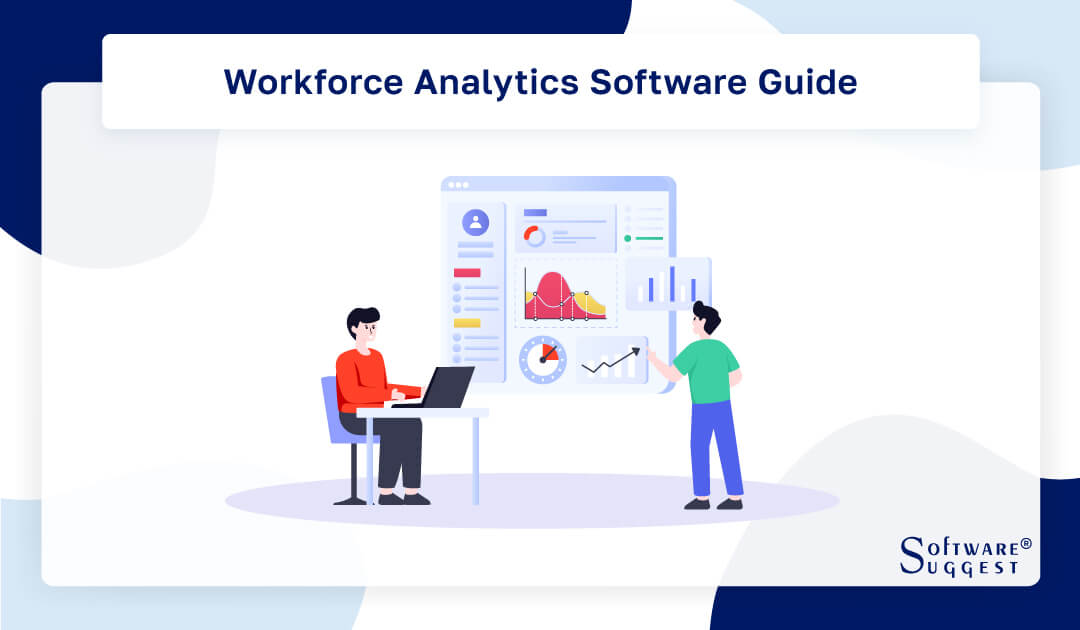
Workforce analytics software revolutionizes how organizations manage and understand their most valuable asset: their workforce. In an era where data-driven decision-making is paramount, this specialized software has emerged as a pivotal tool for businesses of all sizes.
In this buyer’s guide, we will delve into the essential features and benefits of workforce analytics software, highlighting its critical role in shaping modern HR practices and driving organizational success.
What Is a Workforce Analytics Software?
A specialized digital tool created to analyze and evaluate various aspects of an organization's workforce data is called "workforce analytics software." It uses cutting-edge algorithms and the power of data science to give insightful statistics on employee productivity, performance, engagement, and other key HR indicators.
Businesses can use this software to make informed choices about their workforce strategy, including hiring, retaining, and managing employees. Workforce analytics software assists companies in identifying trends, patterns, and potential areas for improvement by combining and analyzing workforce management data from numerous sources, such as HR records, time-tracking systems, and employee feedback.
This knowledge better-equipped organizations to allocate resources effectively, optimize workforce management techniques, and match HR practices to overarching business objectives.
What Is the Purpose of Workforce Analytics?
Workforce analytics software leverages advanced analytics to provide valuable insights into critical areas such as time tracking, employee well-being, and performance metrics. Let's delve into each of these components to grasp their significance in enhancing productivity, employee satisfaction, and overall organizational success.
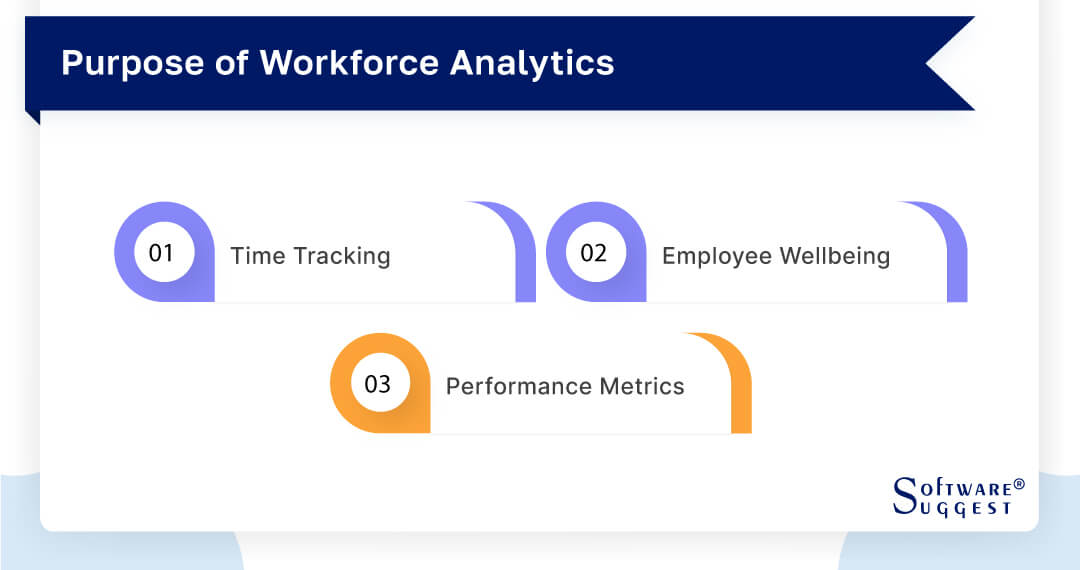
-
Time Tracking
Workforce analytics software excels in capturing and analyzing HR data related to employee time management. It tracks employees' hours in various tasks, projects, and activities. This information serves as a foundation for understanding work patterns, identifying time inefficiencies, and allocating resources effectively.
By comprehensively assessing time utilization, businesses can streamline workflows, allocate resources optimally, and ensure that projects meet deadlines. Additionally, it allows for the identification of high-impact tasks and potential areas for process improvement, leading to increased productivity and enhanced project outcomes.
-
Employee Wellbeing
Workforce analytics software extends its capabilities to monitor and support employee well-being. It gathers data on factors like workload, stress levels, and overall job satisfaction. By assessing this information, organizations can proactively identify areas where employee well-being may be at risk and implement strategies to mitigate potential issues.
This can lead to higher levels of job satisfaction, increased retention rates, and a more positive workplace culture. Moreover, a focus on employee well-being is directly correlated with improved productivity and performance, as employees are more likely to be engaged and motivated when they feel supported and valued.
-
Performance Metrics
One of the fundamental purposes of Workforce analytics software is to track and analyze performance metrics. It provides a comprehensive view of employee performance, including key indicators such as productivity, quality of work, and adherence to goals and targets.
By leveraging this data, organizations can identify high-performing individuals or teams, as well as areas that may require additional training or support.
Performance metrics also enable the establishment of clear, measurable goals and the tracking of progress toward achieving them. This data-driven approach to performance management fosters a culture of accountability and continuous improvement, ultimately driving higher levels of overall organizational performance.
What Is the Difference Between Workforce Analytics and HR Analytics?
Workforce analytics and HR Analytics are related concepts that focus on utilizing data to make informed decisions about an organization's workforce. However, they have distinct scopes and areas of emphasis.
-
Workforce Analytics
Workforce analytics takes a more comprehensive look into an organization's whole workforce, including both permanent staff and temporary help. It entails looking at data from time tracking, employee well-being, performance indicators, and workforce planning, among other workforce-related topics.
By offering knowledge on effectively allocating resources, boosting productivity, and enhancing overall organizational performance, workforce analytics strives to optimize workforce management. It talks about how to strategically manage a dynamic and varied workforce.
-
HR Analytics
HR Analytics, on the other hand, is more specific in its focus, concentrating primarily on the HR function within an organization. It deals with data related to HR processes and practices, including recruitment, talent management, employee engagement, training and development, and compensation.
HR Analytics aims to enhance HR operations by providing insights into areas like hiring effectiveness, employee retention, training program impact, and HR cost analysis. It is primarily concerned with optimizing HR strategies and practices to support the organization's overall goals.
Who Are the Users of Workforce Analytics Software?
Workforce analytics tools serve as a powerful tool for organizations aiming to leverage data-driven insights in their workforce management strategies. Its applications extend across various departments and roles within an organization. Let's explore the key user groups who benefit significantly from this software -
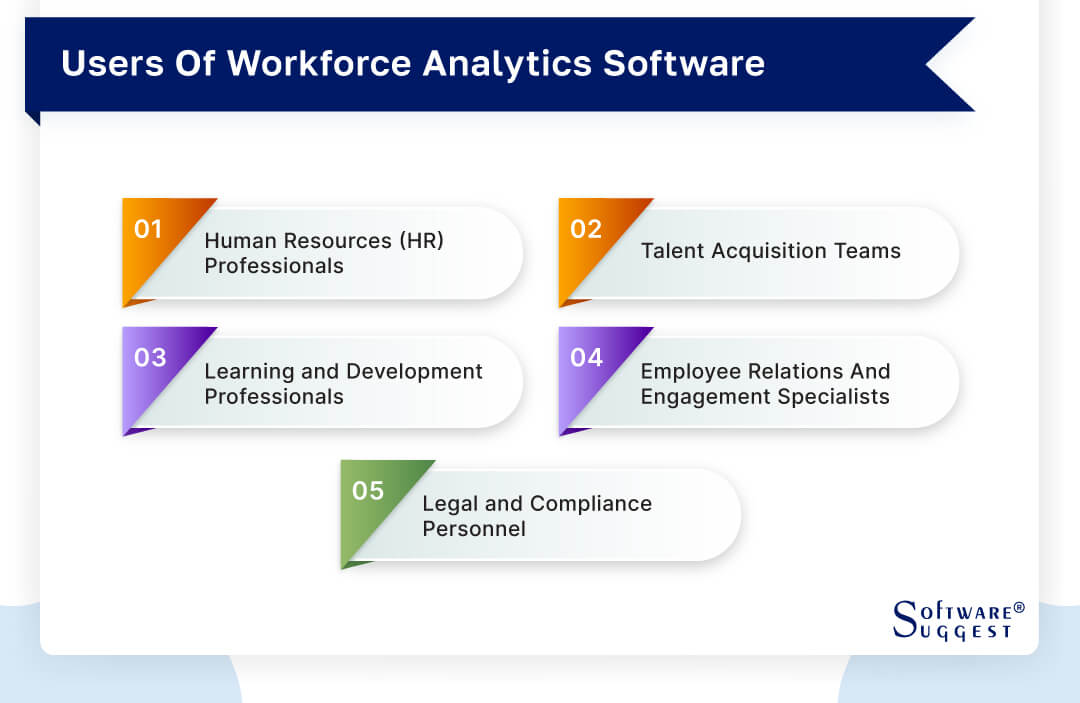
-
Human Resources (HR) Professionals
HR professionals are at the forefront of utilizing workforce analytics software. They rely on it to gain comprehensive insights into various aspects of the workforce, including performance metrics, employee engagement, and compliance. This enables them to make informed decisions regarding recruitment, talent development, and employee relations.
By leveraging data, HR professionals can optimize HR processes and policies to align with organizational goals, ultimately contributing to a more efficient and productive workforce.
-
Talent Acquisition Teams
For talent acquisition teams, workforce analytics tools are invaluable resource. It enables them to make data-driven decisions throughout the recruitment process. By analyzing metrics related to candidate sourcing, assessment, and onboarding, talent acquisition teams can refine their strategies for attracting and hiring top talent.
Additionally, they can track key performance indicators to assess the effectiveness of their recruitment efforts and make adjustments as needed.
-
Learning and Development Professionals
Learning and development professionals use workforce analytics software to enhance training programs and skill development initiatives. By evaluating data on training effectiveness, skill gaps, and employee learning preferences, they can tailor learning experiences to meet the specific needs of employees.
This ensures that training efforts align with organizational objectives and contribute to improved job performance and career development.
-
Employee Relations and Engagement Specialists
Employee relations and engagement specialists leverage workforce analytics software to assess employee satisfaction, well-being, and engagement levels. Through data analysis, they can identify areas of concern or improvement in the workplace environment.
This insight allows them to implement targeted strategies to enhance employee relations, leading to higher levels of job satisfaction, retention, and overall productivity.
-
Legal and Compliance Personnel
Legal and compliance personnel play a critical role in ensuring that an organization adheres to relevant laws and regulations. Workforce analytics system assists them in monitoring compliance with labor laws, diversity and inclusion initiatives, and other legal requirements.
By analyzing data related to workforce demographics and compliance metrics, legal and compliance teams can identify potential areas of risk and take proactive measures to mitigate them.
Benefits of Workforce Analytics Software
By leveraging data-driven insights, workforce analytics software empowers businesses to make informed decisions and optimize various facets of their workforce. Let's explore some of the key benefits that organizations can derive from employing workforce analytics platform:
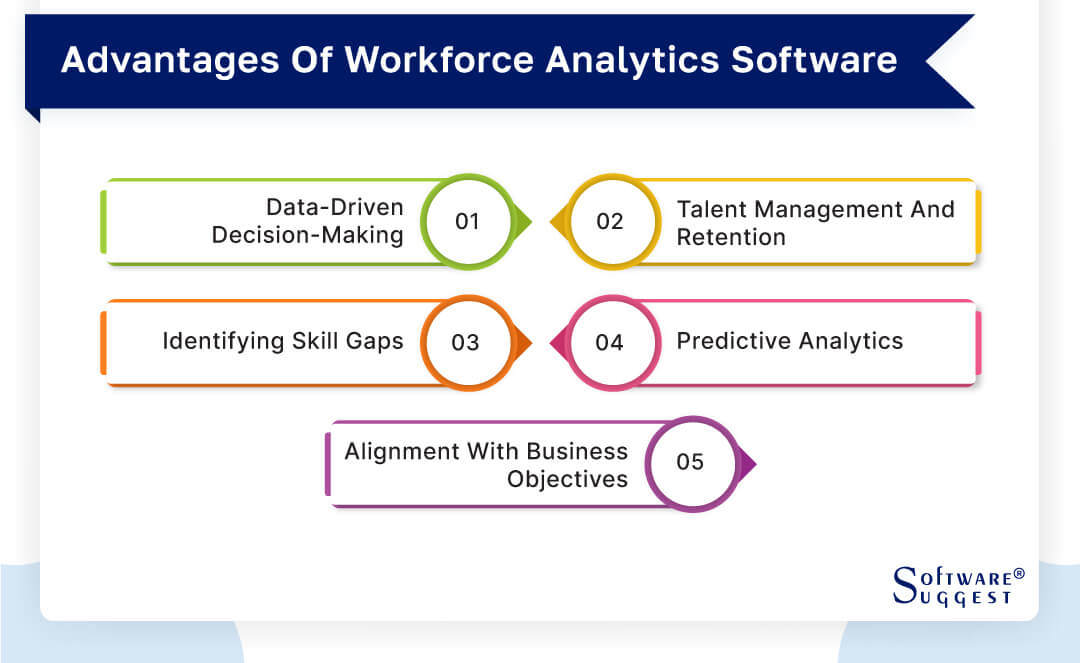
-
Data-Driven Decision-Making
One of the primary advantages of workforce analytics software is its ability to facilitate data-driven decision-making. It provides organizations with a wealth of information about their workforce, including performance metrics, engagement levels, and productivity trends.
This data empowers leaders and managers to make informed choices about recruitment, training, resource allocation, and other critical aspects of workforce management. By relying on objective data rather than intuition or anecdotal evidence, organizations can implement strategies that are more likely to yield positive results.
-
Talent Management and Retention
Workforce analytics software is instrumental in optimizing talent management and retention efforts. By analyzing data related to employee performance, career development, and satisfaction levels, organizations can identify high-potential employees and create tailored development plans.
Additionally, it enables businesses to recognize factors that may contribute to turnover and implement strategies to improve employee retention. This proactive approach to talent management leads to a more engaged and motivated workforce, ultimately driving organizational success.
-
Identifying Skill Gaps
Workforce analytics software provides a comprehensive view of the skills and capabilities within an organization. By assessing the skills possessed by employees and comparing them to the skills required for specific roles or projects, organizations can identify skill gaps.
This information is invaluable for training and development initiatives, enabling businesses to invest in programs that address specific skill deficiencies and ensure that employees have the tools they need to excel in their roles.
-
Predictive Analytics
One of the most powerful features of Workforce analytics software is its ability to employ predictive analytics. By analyzing historical data and trends, organizations can make educated projections about future workforce needs, performance levels, and potential challenges.
This forward-looking approach allows businesses to proactively address issues before they escalate, ensuring they are well-prepared for evolving workforce demands.
-
Alignment with Business Objectives
Workforce analytics software plays a crucial role in aligning workforce management strategies with broader business objectives. It enables organizations to track key performance indicators (KPIs) that are directly tied to organizational goals.
By monitoring these metrics, leaders can ensure that their workforce management efforts are contributing to the overall success and growth of the company. This alignment is essential for maintaining a competitive edge in today's dynamic business environment.
Features of the the Best Workforce Analytics Software
Selecting the right workforce analytics solution is crucial for organizations aiming to optimize their workforce management strategies. The best software in this category offers a range of features designed to provide comprehensive insights and facilitate informed decision-making. Let's explore some of the key features that distinguish the best workforce analytics solution -

-
Customizable Dashboards
The best workforce analytics software provides customizable dashboards that allow users to tailor the display of information to their specific needs. This feature enables organizations to focus on the key metrics and KPIs that are most relevant to their objectives. Customizable dashboards enhance user experience and ensure that decision-makers have immediate access to the critical data they require.
-
Talent Management Tools
Top-tier workforce analytics software includes robust talent management tools that support various aspects of employee development and retention. These tools may encompass performance evaluations, skill assessments, succession planning, and career pathing.
By providing a comprehensive view of an employee's capabilities and potential, these features aid in optimizing talent management strategies and fostering a culture of growth and advancement.
-
Drill-Down Capabilities
Effective workforce analytics software offers drill-down capabilities, allowing users to delve into specific data points for deeper analysis. This feature is invaluable for identifying trends, uncovering root causes of performance issues, and gaining a more granular understanding of workforce dynamics. With the ability to drill down into detailed data, organizations can make more accurate and targeted decisions.
-
Benchmarking
The best workforce analytics software often includes benchmarking functionality. This feature allows organizations to compare their performance metrics with industry standards or against peer organizations.
Benchmarking provides valuable context for understanding how an organization's workforce measures up in terms of productivity, engagement, and other key indicators. This information is essential for setting realistic performance goals and identifying areas for improvement.
-
Feedback and Collaboration
Feedback and collaboration tools are crucial components of top-notch workforce analytics software. These features facilitate communication and knowledge sharing among team members, enabling them to collaborate effectively on projects and initiatives.
Additionally, feedback mechanisms allow for continuous improvement by gathering input from employees and stakeholders, ensuring that workforce strategies are aligned with organizational goals and employee needs.
How to Select the Right Workforce Analytics Software?
Selecting the right workforce analytics software is a critical decision for organizations aiming to enhance their workforce management capabilities. To ensure that the chosen software aligns with your specific requirements and business goals, it's important to follow a structured selection process. Here are some key steps to help you make an informed choice -
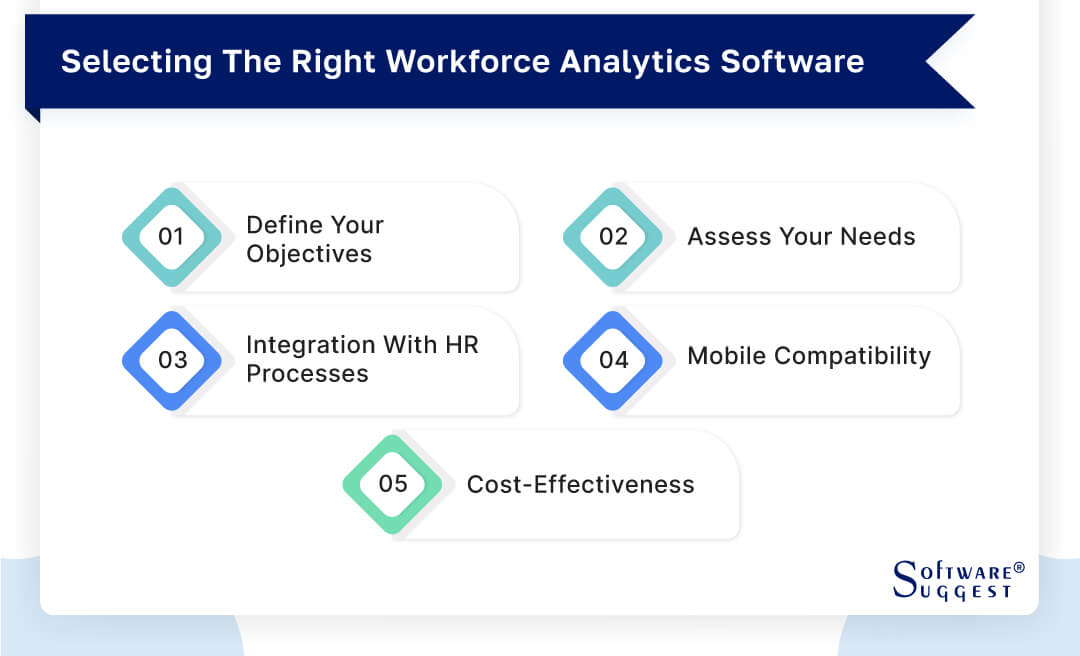
-
Define Your Objectives
Begin by clearly defining your objectives for implementing workforce analytics software. Consider what specific insights and data-driven solutions you hope to achieve. Are you primarily focused on improving talent acquisition, optimizing employee performance, or enhancing overall workforce productivity? Having a clear understanding of your goals will guide you in evaluating which software aligns best with your organizational priorities.
-
Assess Your Needs
Conduct a comprehensive assessment of your organization's specific needs and challenges. This involves identifying the key areas where workforce analytics can make the most significant impact. Consider factors such as talent management, employee engagement, performance evaluation, and compliance.
By understanding your unique requirements, you can prioritize features and functionalities that are essential for addressing your specific workforce management goals.
-
Integration with HR Processes
Compatibility and seamless integration with existing HR processes and systems are crucial factors to consider. The chosen workforce analytics software should be able to integrate with your current HR management tools, such as HRIS (Human Resource Information System), time and attendance systems, and performance management platforms. This ensures a smooth flow of data and avoids duplication of efforts in data entry and management.
-
Mobile Compatibility
In today's dynamic work environment, accessibility is key. Ensure that the workforce analytics software you choose is compatible with mobile devices. This allows stakeholders and decision-makers to access critical workforce data on the go. Whether in meetings, on-site visits, or remote work situations, mobile compatibility ensures that key personnel have real-time access to essential information, enabling prompt and informed decision-making.
-
Cost-Effectiveness
Evaluate the cost-effectiveness of the workforce analytics software in relation to the benefits it provides. Consider factors such as licensing fees, implementation costs, and potential additional expenses for customization or ongoing support.
Additionally, assess the potential return on investment (ROI) in terms of improved productivity, reduced turnover, and other tangible benefits. Striking a balance between cost and expected benefits is crucial for a successful implementation.
Market Trends in Workforce Analytics Software
For businesses looking to maintain their competitive edge and manage their workforces efficiently, staying up to date on market trends in workforce analytics software is essential. Let's look at some of the major market trends that are now influencing the workforce analytics software industry -
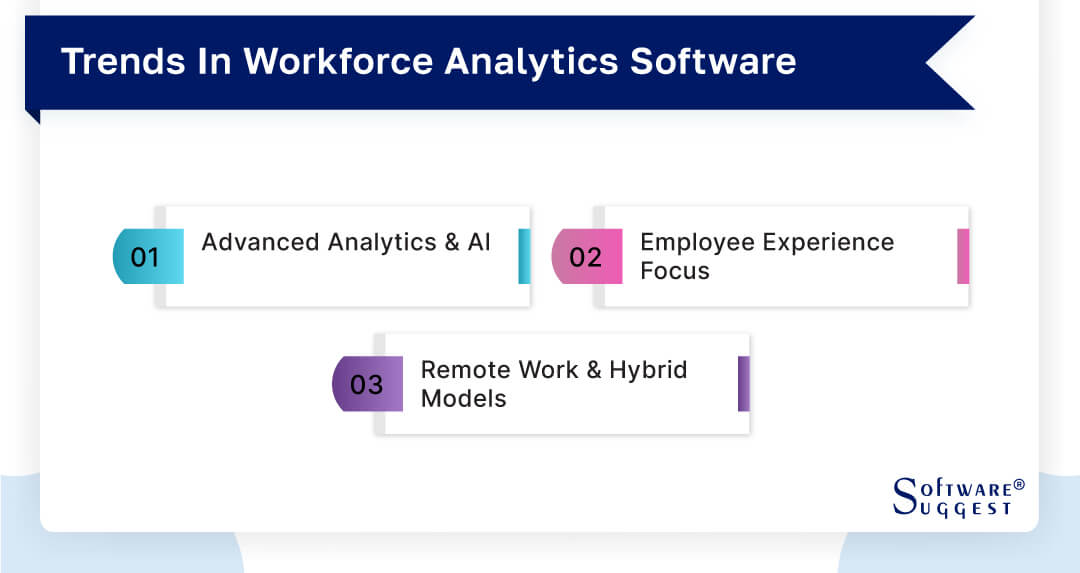
-
Advanced Analytics and AI
The future of workforce analytics is being led by advanced analytics and Artificial Intelligence (AI). These innovations are transforming how businesses collect and analyze workforce data. Deeper and more subtle insights are made possible by advanced analytics algorithms, allowing for the discovery of patterns, trends, and correlations that might have been challenging to spot using conventional approaches.
AI-powered solutions can forecast workforce trends, help recruit top people, and even help discover potential areas for staff training and growth. Organizations are able to make better decisions regarding their workforce thanks to the integration of AI and advanced analytics into workforce analytics software.
-
Employee Experience Focus
In workforce analytics, improving the employee experience is a key trend. Organizations are using analytics to better analyze and improve employee sentiment, happiness, and well-being because they know that happy and engaged workers are more productive and likely to stick with the firm.
Features for monitoring and evaluating employee comments, attitudes, and engagement levels are increasingly available in workforce analytics software. Organizations can implement targeted tactics that improve the overall working environment and foster a healthy workplace culture thanks to this data-driven approach.
-
Remote Work and Hybrid Models
The shift towards remote work and hybrid work models has been accelerated by global events. As a result, workforce analytics software is adapting to accommodate this new reality. Organizations are seeking tools that enable them to effectively manage and measure the performance of remote and hybrid teams.
Workforce analytics software now includes features that track remote work productivity, collaboration patterns, and employee well-being in virtual work environments. This trend reflects the need for adaptable and flexible workforce management solutions that can thrive in a distributed work landscape.
What Is the Cost of Workforce Analytics Software?
The cost of workforce analytics software can vary significantly depending on several factors. These include the scale of the organization, the specific features and functionalities required, the complexity of data integration, and the level of customization needed. For smaller organizations or startups, there are more budget-friendly options available, often with basic analytics capabilities.
On the other hand, larger enterprises with extensive workforce management needs may opt for more comprehensive and sophisticated solutions, which can come with a higher price tag. Additionally, subscription models are common in the industry, where organizations pay a monthly or annual fee based on the number of users or the level of service required. It's also important to consider potential additional costs for implementation, training, and ongoing support.
Organizations should carefully evaluate their specific requirements and budget constraints when selecting workforce analytics software to ensure that it aligns with their financial considerations while providing the necessary analytical capabilities.
Conclusion
Workforce analytics software stands as a transformative tool in the realm of modern workforce management. Its ability to harness data-driven insights revolutionizes how organizations understand, engage, and optimize their workforce. By offering features such as advanced analytics, talent management tools, and benchmarking capabilities, it empowers businesses to make informed decisions that directly impact productivity, employee satisfaction, and overall organizational success.
FAQs
There are several different types of workforce analytics, each focusing on specific aspects of workforce management and providing unique insights:
- Descriptive Analytics
- Diagnostic Analytics
- Predictive Analytics
- Prescriptive Analytics
- Benchmarking Analytics
- Employee Engagement Analytics
- Talent Acquisition Analytics
- Learning and Development Analytics
- Workforce Planning Analytics
- Compliance and Diversity Analytics
An organization's workforce data must be analyzed and interpreted by a specialist known as a workforce analyst. They are essential in assisting companies in making knowledgeable decisions about their staff in regard to matters like hiring, performance, retention, and talent development. To glean valuable insights from data, workforce analysts employ a variety of analytical strategies, statistical models, and specialized software.
To conduct a workforce analysis, start by gathering relevant data on your organization's workforce. This includes information on employee demographics, roles, performance metrics, and any other pertinent factors. Next, categorize and organize this data for easy analysis. Identify key performance indicators (KPIs) and metrics that are important to your organization's goals, such as turnover rates, productivity, and skill gaps.






















